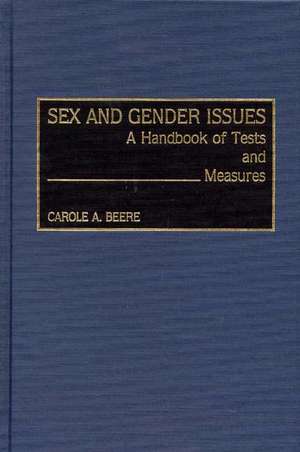Sex and Gender Issues: A Handbook of Tests and Measures
Autor Carole A. Beereen Limba Engleză Hardback – 19 noi 1990 – vârsta până la 17 ani
Preț: 328.02 lei
Preț vechi: 618.99 lei
-47% Nou
Puncte Express: 492
Preț estimativ în valută:
62.78€ • 64.85$ • 52.24£
62.78€ • 64.85$ • 52.24£
Carte tipărită la comandă
Livrare economică 26 martie-09 aprilie
Preluare comenzi: 021 569.72.76
Specificații
ISBN-13: 9780313274626
ISBN-10: 0313274622
Pagini: 448
Dimensiuni: 156 x 235 x 41 mm
Greutate: 1.03 kg
Ediția:New.
Editura: Bloomsbury Publishing
Colecția Greenwood
Locul publicării:New York, United States
ISBN-10: 0313274622
Pagini: 448
Dimensiuni: 156 x 235 x 41 mm
Greutate: 1.03 kg
Ediția:New.
Editura: Bloomsbury Publishing
Colecția Greenwood
Locul publicării:New York, United States
Notă biografică
CAROLE A. BEERE is Associate Dean for Graduate Study Research at Central Michigan University. She is the author of Women and Women's Issues and Gender Roles: A Handbook of Tests and Measures (Greenwood Press, 1990). She has also contributed articles to Sex Roles and Psychology in the Schools.
Cuprins
IntroductionHeterosocial RelationsSexualityContraception and AbortionPregnancy and ChildbirthSomatic IssuesHomosexualityRape and Sexual CoercionFamily ViolenceBody Image and AppearanceEating DisordersOther ScalesBibliographyIndex of Scale TitlesIndex of Scale AuthorsIndex of Variables Measured by ScalesIndex of Users
Recenzii
Beere (psychology, Central Michigan University) has written another useful reference book. This latest is actually a continuation of Gender Roles: A Handbook of Tests and Measures. In her attempt to update her first book, Women and Women's Issues: A Handbook of Tests and Measures, she identified too many measures for one volume. So she split the tests into two categories: gender issues and gender roles. Those dealing with issues are included in this current volume; 211 tests related to roles are identified in the previous volume, Gender Roles. The book under review identifies 197 tests on many different topics including sexuality, pregnancy and childbirth, contraception and abortion, and eating disorders. Many of the test entries contain the following information: title, author, variable measured, instrument type, description, sample items, administration, reliability, validity, and test availability. The tone of the entries is descriptive in nature rather than critical or evaluative. Beere has been extremely thorough in gathering information and has taken great care with accuracy. She has even attempted to view each instrument before including it in this book. Students and faculty will find Sex and Gender Issues worthwhile and easy to use. Highly recommended for four-year college and university libraries.
Such books are a godsend for active researchers and for students looking for information on hard-to-find tests. Here, one is delighted to discover information on almost 200 different instruments, most but not all of paper-and-pencil type, relating to sex and gender issues. The format for each test includes the title and author(s), date, variable(s) measured, type of instrument (68% are summated rating scales), sample items, type of subjects in previous use, subjects for which the instrument is appropriate, administration, scoring, scale development, reliability and validity issues, other relevant information (notes and comments), availability, a listing of studies which have used the instrument, and a bibliography. Each of the 197 instruments are grouped in one of these relevant categories: heterosexual relations, sexuality, rape and sexual coercion, family violence, body image and appearance, eating disorders, and other. There are indexes of scale titles, scale authors, and scale users. This is a volume no college or university with strong collections in psychology and especially in sex and gender issues can afford to be without. Graduate faculties and students will bless the author and publisher for this thorough and eminently useful work.
Such books are a godsend for active researchers and for students looking for information on hard-to-find tests. Here, one is delighted to discover information on almost 200 different instruments, most but not all of paper-and-pencil type, relating to sex and gender issues. The format for each test includes the title and author(s), date, variable(s) measured, type of instrument (68% are summated rating scales), sample items, type of subjects in previous use, subjects for which the instrument is appropriate, administration, scoring, scale development, reliability and validity issues, other relevant information (notes and comments), availability, a listing of studies which have used the instrument, and a bibliography. Each of the 197 instruments are grouped in one of these relevant categories: heterosexual relations, sexuality, rape and sexual coercion, family violence, body image and appearance, eating disorders, and other. There are indexes of scale titles, scale authors, and scale users. This is a volume no college or university with strong collections in psychology and especially in sex and gender issues can afford to be without. Graduate faculties and students will bless the author and publisher for this thorough and eminently useful work.











